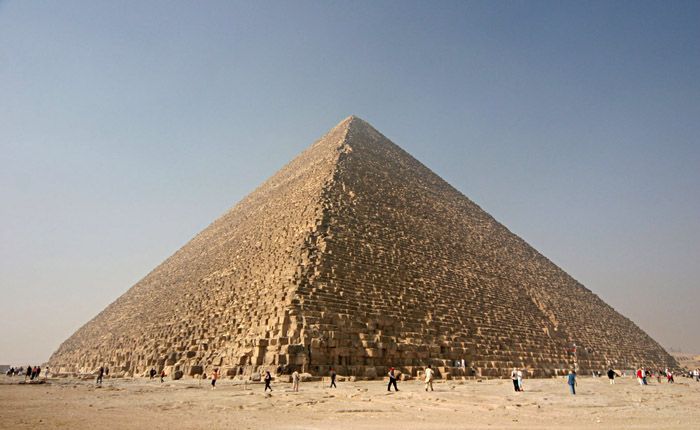The Great Pyramid of Giza: The Mystery Solved
Project Release Date: 15 March 2014
This is the data page for this project. Here you can read about the experiment and see the paper and pen remote-viewing sessions that were done for this project. However, video sessions were also conducted for this project, and they can be seen in the video release this project. There is a video announcement associated with this project, and you can see that by clicking on the "Watch Now!" button.
![]() This connects you with the video page for this project.
This connects you with the video page for this project.
Project Overview
This remote-viewing investigation answers the questions of who built the Great Pyramid of Giza, why was built, and for what was it originally used. This pyramid is alternately known as the Pyramid of Khufu, or the Cheops Pyramid. Here is a picture of the pyramid.

For this project, the above figure is used to define the target, and it is referenced below as "figure 1." Photo credit: Nina Aldin Thune (from Creative Commons of Wikipedia)
Principal Investigator for this project: Courtney Brown
Blind Conditions for all Remote-Viewing Data: All remote viewing for this project (as with all projects conducted at The Farsight Institute) was conducted under totally blind conditions. The viewers were told nothing about the project or specific targets while they were conducting their remote-viewing sessions. They were only instructed by a non-leading email that there is a target, and that they should remote view it. To understand the differences between an operational project such as this one and a strictly scientific project (such as our Multiple Universes Project), see the discussion on our Mysteries Project main page.
A Note About the Quality of the Remote Viewing for This Project: This is clearly an important project in the history of remote viewing. The mystery surrounding the construction and purpose of the ancient Egyptian pyramids has been the focus of countless narratives and speculative hypotheses going back thousands of years. Thus, the quality of the remote viewing for this project is of ultimate concern. The two remote viewers participating in this project, Dick Allgire and Daz Smith, are arguably among the very best remote viewers on the planet currently. They have long and well-documented public track records for remote viewing, a great deal of which is available to see on the web site for The Farsight Institute in projects spaning a great many years. The quality of the remote-viewing sessions for this project is absolutely stellar. These are not sessions containing vague impressions that suggest possible target contact. Rather, these remote-viewing sessions are clear representations of the targets, both verbally and with unambiguous drawings. People are encouraged to both read all of the session summaries for this project, but also to closely examine each page of the individual remote-viewing sessions to fully appreciate the quality of these remote-viewing efforts in terms of accuracy, as well as the breadth and depth of the perceptions.
The Remote-Viewing Targets
NOTE: There are six targets for this project, Targets 7a through 7f. Two of the targets are nearly identical in wording for this series. That is, Target 7a is essentially the same as Target 7d. The reason this was done is because of the concern that the picture of the pyramid found in Target 7a might draw all viewers to the pyramid itself rather than the actual target as defined in its wording. Target 7a is the mining of the largest rocks used in building the pyramid, and the intent of the target is to have the viewers perceive the actual mining process itself without being distracted by the psychic impression of the huge finished monolithic structure. Having the viewers revisit this target using separate target definitions that alternatively do or do not contain the image of the pyramid was thought to help isolate the actual intent of the target.
Why does this matter if the viewers are not told anything about the target when they do their remote-viewing sessions? Past research into the remote-viewing phenomenon conducted at The Farsight Institute demonstrated that the focus of a remote viewer's perceptions during a remote-viewing session is mediated by a telepathic connection between the remote viewer when the session is being conducted and the person who first compares the remote-viewing data to the actual target, who in this case is the analyst (Courtney Brown). Thus, the analyst would have the target definition in front of him when the data are being initially examined, and the presence or absence of the pyramid image at the time of this initial examination might influence the focus of the perceptions of the remote viewers. Thus, targets were designed which both did and did not contain the image of the pyramid.
| ||||||
| ||||||